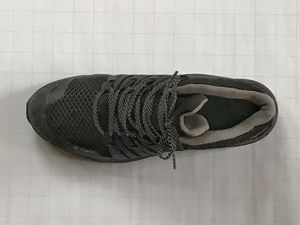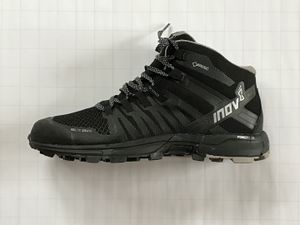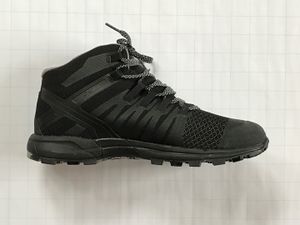Difference between revisions of "Inov-8 Roclite 325"
User:Fellrnr (User talk:Fellrnr | contribs) (Created page with "{{DISPLAYTITLE: Inov-8 Roclite 325 GTX}} The Inov-8 Roclite 325 GTX is a hiking boot from Inov-8, a company better known for its trail running shoes. The Roclite range of shoe...") |
(No difference)
|
Latest revision as of 06:16, 17 August 2017
The Inov-8 Roclite 325 GTX is a hiking boot from Inov-8, a company better known for its trail running shoes. The Roclite range of shoes and boots is it designed to be versatile, offering a blend of protection and grip on rocky trails, lugs for traction on soft mud, as well as reasonable smoothness on the road. I've found that Inov-8 have largely succeeded in their goal, and the Roclite is a versatile boot. It doesn't offer the level of cushioning (and therefore protection) of my favorite hiking boot, the Hoka Tor Ultra, but you shouldn't really expect that in what is clearly a running shoe that comes up high rather than a true hiking boot. The main issue I have with this boot is the shape of the toe box, a common failing in most footwear. Unfortunately, unlike some of Inov-8's better offerings, this boot has an extremely cramped toe box. While I prefer the Hoka, I think this boot is well worth your consideration.
1 The Name and the Origins
The 325 in the name should refer to the weight of a shoe in grams, but in this case, it's a little misleading. The story starts with the Roclite 305 running shoe, the forms the basis of this boot. You then get the Roclite 325 boot, which is the 305 with an upper that comes up over the ankle. Then there are Gore-Tex versions of the 305 and 235, but the extra weight of the Gore-Tex liner is not included in the name, so the Roclite 325 GTX actually weighs 257g/12.6oz. That's still really like to for a hiking boot; compare it with the Salomon Quest 4D II GTX weighs 550g/19.4oz and is considered a relatively lightweight boot.
2 Waterproofing
To keep your feet dry, you'll need to wear waterproof trousers in the rain, or the water will simply run down your legs and fills the boot. If you're not going to wear waterproof trousers in the rain, then I'd recommend going for a non-waterproof shoe that will dry quickly, such as the Hoka Mafate or the Roclite 305 running shoe. Like all waterproof boots that use a membrane, over time the membrane will fail and let water into the boot. This is the worst of all worlds, because now you're boot will get wet inside, but the remaining waterproof membrane will prevent the water leaving and keep your feet wet. Before any major trip I would recommend filling your boots with water and checking for any leaks.
3 Characteristics
- Cushioning . The 325 is a better cushioned than you might expect given its weight, but it's nothing like the massively cushioned Hoka hiking boots. Some of the cushioning comes from the outsole lugs, but there's also quite a bit of foam midsole.
- Drop. Inov-8 claim 8mm drop, and while it's tricky for me to measure the actual drop with my equipment and it's focused on shoes, I would say that it's a fair bit less than 8 mm. Certainly I never feel like I'm hiking in high heels, as is so common in many hiking boots.
- Structure. There is no medial post or other devices to interfere with your biomechanics, so things are nicely neutral and unobtrusive.
- Flexibility. The Roclite 235 is pretty flexible, though it does have a "meta-flex" prove that does create a line where the boot wants to flex. If that doesn't quite line up with way your foot flexes, that can be problematic, but in this case I found the crease to be fairly minor. There is some inflexibility from a shank that is added under the arch, but given the human foot doesn't bend there this should be immaterial.
- Outsole. The outsole is fairly sticky, though I prefer the grip I get from the Hoka hiking boots. There are some reasonably aggressive outsole lugs that should provide some traction on soft terrain.
- Shape. Sadly, the Roclite is clearly not designed to fit the human foot. This is a particular pain in a waterproof hiking boot, as you don't want to cut it open for fit. I found the shape to be a deal breaker, but if you have toe deformities through years of wearing shoes with cramped toe boxes you may find you can get away with this boot.
- Upper. The upper of the Roclite 325 is thin and flexible over the forefoot, and only slightly stiffer in the rear. While I haven't had any problems so far, the area of the front of the shoe way you can see a diamond pattern feels rather thin and vulnerable. There's a bit of a reinforced toe that may help with abrasions, but not so much for stubbed toes. There's a good amount of padding around the ankle, and the height is best considered "meat height", so your ankle movement isn't impaired significantly. For waterproofing, Inov-8 use Gore-Tex, though it doesn't mention any specific variety (there are many.) I like the use of a well-established waterproof membrane rather than something unusual. While the membrane is breathable, it's not breathable enough to keep up with your sweat rate in warmer conditions. Just like an old school leather shoe, the best option is to swap your socks periodically.
- Tongue. The 325 is a tongueless, booty style upper for most of its length, dividing out into a traditional tongue just above the crook of the ankle. This means it's waterproof to around 4.5 inches/11cm.
- Lacing. The laces are flat and stay tied nicely. Unlike a traditional hiking boot, the lace holes go all the way up, rather than having at the top if you replaced by hooks. The lacing hooks make it vastly easier to get in and out of the boot, and the use of eyeholes really annoyed me.
- Heel Counter. There's not much of a Heel Counter which is a nice change.

| This review was made possible by readers like you buying products via my links. I buy all the products I review through normal retail channels, which allows me to create unbiased reviews free from the influence of reciprocity, or the need to keep vendors happy. It also ensures I don't get "reviewer specials" that are better than the retail versions.
|



